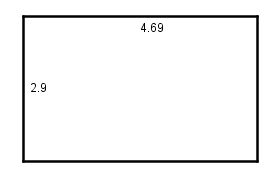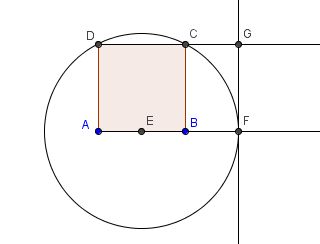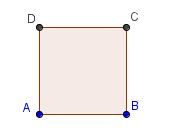One of the best things about teaching math is sharing all of the connections that exist between seemingly unrelated topics. Take, for example, the Golden Rectangle. Often described as the most visually “pleasing” quadrilateral, it is a rectangle whose length, l, and whose width, w, are in the the proportion .
Here’s an example:
 4.69 / 2.9 = 1.62, and (4.69 + 2.9) / 4.69 = 1.62. The number they equal, 1.62, is called the Golden Ratio, and it has its own Greek letter, phi. It’s actually irrational, like pi and e, and it equals
4.69 / 2.9 = 1.62, and (4.69 + 2.9) / 4.69 = 1.62. The number they equal, 1.62, is called the Golden Ratio, and it has its own Greek letter, phi. It’s actually irrational, like pi and e, and it equals . You can derive phi algebraically by solving
for l in terms of w. From the quadratic formula,
, so
.
A Golden Rectangle can be constructed with a straightedge and compass (or GeoGebra!):
2. Construct the midpoint, E, of side AB.
3. Construct a circle with center at E, passing through C: 
4. Extend rays through AB and DC. Construct the intersection point, F, of the circle and ray AB.
5. Construct a line perpendicular to ray AB, through point F. Construct the intersection point, G, of this perpendicular line and ray DC: 
6. Quadrilateral AFGD is a Golden Rectangle.
Another way to construct a Golden Rectangle is to begin with two adjacent squares:
Add another adjacent square with dimension equal to the combined sides of the first two:
Repeat the process, adding larger and larger adjacent squares:
This not an exact Golden Rectangle, but the more squares you add, the closer it approximates a true one.
Here is where Fibonacci comes in. He was a 13th century mathematician who published one of the first math textbooks, Liber Abaci. One of the topics he covered involved a famous sequence that can represent the idealized population growth of rabbits: 1, 1, 2, 3, 5, 8, 13, 21, 34, …. Each term is obtained by adding the previous two terms together. Can you see how the rectangle above is a visual representation of the Fibonacci Sequence? What is amazing is the fact that the quotient of any two consecutive terms in the sequence approaches phi the further up the sequence you go!
Connecting opposite corners of each square with a circular arc creates a Golden Spiral, which increases a distance of phi from the origin for each square it crosses:
There are lots of exaggerated claims made about the use of the Golden Rectangle and phi in ancient architecture, but it definitely pops up in the world of nature. Flowers generally have petals in numbers of 3, 5, 8, 13, 21, etc. For an excellent explanation of the mathematical reasons behind this pattern, check out Ian Stewart’s book, The Mathematics of Life.
A rectangle, a medieval Italian mathematician, a famous sequence, and the number of petals on flowers – all brought together through the beauty of mathematics.






Reblogged this on Stormfields.